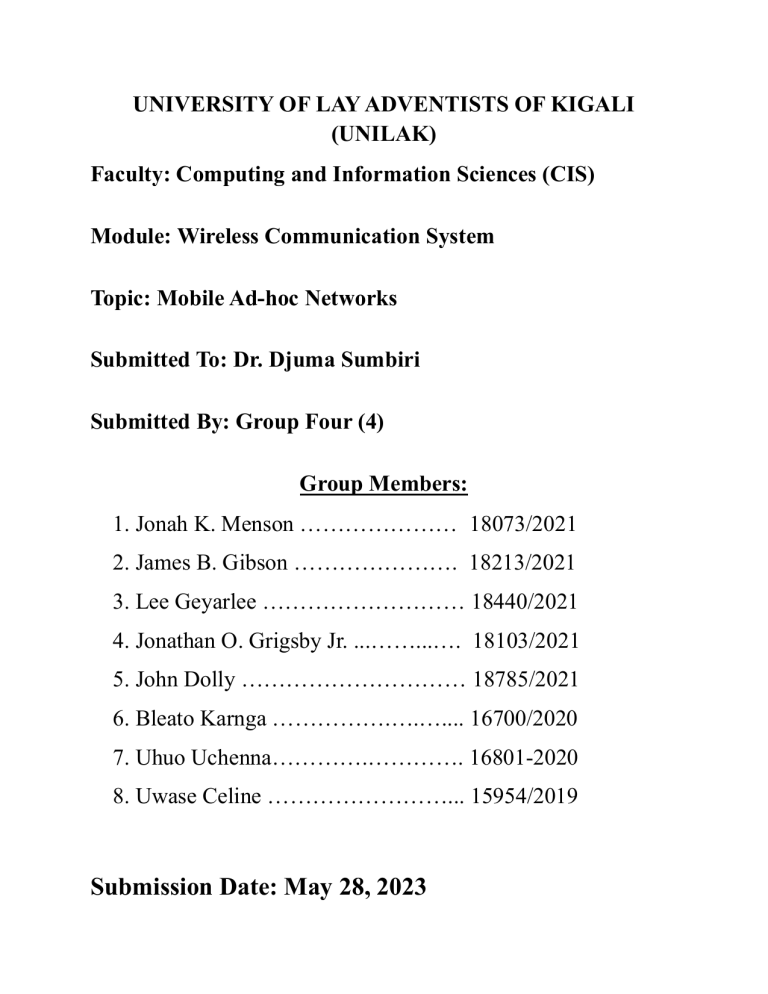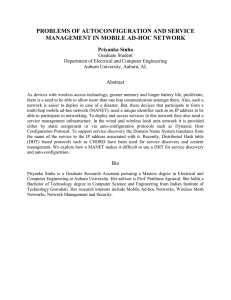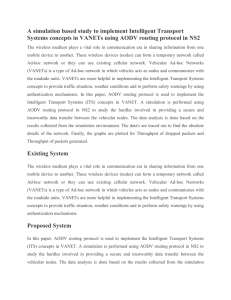
UNIVERSITY OF LAY ADVENTISTS OF KIGALI (UNILAK) Faculty: Computing and Information Sciences (CIS) Module: Wireless Communication System Topic: Mobile Ad-hoc Networks Submitted To: Dr. Djuma Sumbiri Submitted By: Group Four (4) Group Members: 1. Jonah K. Menson ………………… 18073/2021 2. James B. Gibson …………………. 18213/2021 3. Lee Geyarlee ……………………… 18440/2021 4. Jonathan O. Grigsby Jr. ...……...…. 18103/2021 5. John Dolly ………………………… 18785/2021 6. Bleato Karnga …………….….….... 16700/2020 7. Uhuo Uchenna………….…………. 16801-2020 8. Uwase Celine ……………………... 15954/2019 Submission Date: May 28, 2023 Introduction Mobile Ad-hoc Network (MANET): Mobile Ad hoc Networks (MANETs) are self-configuring, infrastructure-less networks consisting of mobile devices (nodes) that communicate with each other without the need for a centralized infrastructure such as routers or access points. In a MANET, each node can act as both a transmitter and a receiver, and the network topology can change dynamically as nodes move around, join or leave the network. Each device in a MANET is free to move independently in any direction and will therefore change its links to other devices frequently. CHARACTERISTICS OF MANET 1. In MANET, each node acts as both host and router. That is, it is autonomous in behavior. 2. The nodes can join or leave the network anytime, making the network topology dynamic in nature. 3. Mobile nodes are characterized with less memory, power and light weight features. 4. All nodes have identical features with similar responsibilities and capabilities and hence it forms a completely symmetric environment. 5. When a source node and destination node for a message is out of the radio range, the MANETs are capable of multi-hop routing. DIAGRAM OF A MOBILE AD-HOC NETWORK TYPES OF MANETs 1. Vehicular ad-hoc networks (VANETs): VANETs are used for communication between vehicles and roadside equipment. Vehicular Ad-Hoc Networks (VANETs) play a crucial role in enhancing road safety and mitigating accidents or collisions. DIAGRAM TWO OF VANETs 2. Smart phone ad-hoc networks (SPANs) Smartphone Ad-Hoc Networks (SPANs) are wireless communication networks formed by smartphones or other mobile devices without relying on a centralized infrastructure, such as cellular towers or Wi-Fi access points. 3. Internet-based mobile ad-hoc networks (iMANETs): iMANETs are ad-hoc networks that link mobile nodes and fixed Internet-gateway nodes. For example, multiple sub-MANETs may be connected in a classic Hub-Spoken VPN to create a geographically distributed MANET. PROS OF MANET 1. Scalable: MANETs are scalable because a greater number of nodes can be formed. 2. The network can be set up at any place and time 3. Less expensive as compared to wired network. 4. They provide access to inform and services regardless of geographic position. CHALLENGES OF MANET 1. The wireless link characteristics are time-varying in nature i.e.: There are transmission impediments like fading, path loss, blockage and interference that adds to the susceptible behavior of wireless channels. 2. Limited range of wireless transmission i.e.: The data rates are low when compared to wireless networks 3. Packet losses due to errors in transmission i.e.: MANETs experience higher packet loss due to factors such as hidden terminals that results in collisions, interference, frequent breakage in paths caused by mobility of nodes, increased collisions due to the presence of hidden terminals problems. 4. Frequent networks partitions The random movement of nodes often leads to partition of the network. This mostly affects the intermediate nodes. 5. Limitations of Mobile Nodes The mobile nodes have short battery life. Characteristics of MANET cont… i. Dynamic Topologies: Network topology which is typically multihop may change randomly and rapidly with time, it can form unidirectional or bi-directional links. ii. Bandwidth constrained, variable capacity links: Wireless links usually have lower reliability, efficiency, stability, and capacity as compared to a wired network iii. Autonomous Behavior: Each node can act as a host and router, which shows its autonomous behavior. iv. Energy Constrained Operation: As some or all the nodes rely on batteries or other exhaustible means for their energy. Mobile nodes are characterized by less memory, power, and lightweight features. v. Limited Security: Wireless networks are more prone to security threats. A centralized firewall is absent due to the distributed nature of the operation for security, routing, and host configuration. vi. Less Human Intervention: They require minimum human intervention to configure the network, therefore they are dynamically autonomous in nature. Advantages: i. Flexibility: MANETs are highly flexible, as they can be easily deployed in various environments and can be adapted to different applications and scenarios. This makes them ideal for use in emergency situations or military operations, where there may not be a pre-existing network infrastructure. ii. Scalability: MANETs can easily scale to accommodate a large number of nodes, making them suitable for large-scale deployments. They can also handle dynamic changes in network topology, such as the addition or removal of nodes. iii. Cost-effective: Since MANETs do not require any centralized infrastructure, they are often more cost-effective than traditional wired or wireless networks. They can also be used to extend the range of existing networks without the need for additional infrastructure. iv. Rapid Deployment: MANETs can be rapidly deployed in areas where infrastructure is not available, such as disaster zones or rural areas. Disadvantages: i. Security: MANETs are vulnerable to security threats, such as attacks by malicious nodes, eavesdropping, and data interception. Since the network is decentralized, there is no central authority to ensure the security of the network. ii. Reliability: MANETs are less reliable than traditional networks, as they are subject to interference, signal attenuation, and other environmental factors that can affect the quality of the connection. iii. Bandwidth: Since MANETs rely on wireless communication, bandwidth can be limited. This can lead to congestion and delays, particularly when multiple nodes are competing for the same channel. iv. Routing: Routing in MANETs can be complex, particularly when dealing with dynamic network topologies. This can result in inefficient routing and longer delays in data transmission. v. Power Consumption: Since MANETs rely on battery-powered devices, power consumption can be a significant issue. Nodes may need to conserve power to extend the life of the battery, which can limit the amount of data that can be transmitted. APPLICATIONS OF MANET 1. Military Mobile Ad-hoc Network would allow the military to take advantage of technology to maintain an information network between the soldiers, vehicles, and military information headquarters. 2. Rescue Operation Ad-hoc can be used in emergency or rescue operations for disaster relief efforts, e.g., in fire, flood, or earthquake. 3. Business Work Whenever any emergency meeting is planned outside the office exchange of information on a given project is made possible by means of MANET. 4. Classroom and Conference Mobile Ad-hoc networks can autonomously link an instant and temporary multimedia network using notebook computers to spread and share information among participants. Example, conference or classroom. THE THREE TYPES OF MANETs 1. Vehicular Ad-Hoc Networks (VANETs): Vehicular Ad-Hoc Networks (VANETs) play a crucial role in enhancing road safety and mitigating accidents or collisions. Here are some ways in which VANETs can help: i. Collision Warning Systems: VANETs enable vehicles to communicate with each other and exchange information in real-time. This communication can be utilized to develop collision warning systems. For example, if a vehicle detects a potential collision with another vehicle ahead, it can transmit a warning message to nearby vehicles, alerting them to the danger and allowing them to take appropriate actions, such as braking or changing lanes. ii. Emergency Vehicle Notification: VANETs facilitate the quick dissemination of information about emergency vehicles, such as ambulances, police cars, or fire trucks. When an emergency vehicle is approaching, it can transmit a signal to nearby vehicles, notifying them of its presence and requesting the right of way. This helps in clearing a path for the emergency vehicle, reducing response times, and potentially saving lives. iii. Traffic Congestion Management: VANETs enable vehicles to share information about traffic conditions, such as congestion, accidents, or road closures, with other vehicles in the network. This information can be used to dynamically adjust routes and redirect vehicles to less congested paths, reducing the likelihood of accidents caused by heavy traffic or gridlock situations. iv. Intersection Safety: Intersections are often high-risk areas for accidents. VANETs can enhance intersection safety by enabling vehicles to communicate their positions, speed, and intentions to other vehicles approaching the intersection. This information can be used to coordinate traffic signals and optimize the timing of traffic lights, improving traffic flow and reducing the likelihood of collisions. v. Pedestrian Safety: VANETs can also enhance pedestrian safety by enabling vehicles and pedestrians to communicate with each other. For example, a pedestrian equipped with a mobile device can transmit their presence and location information to nearby vehicles. Vehicles can then use this information to detect pedestrians in their vicinity and take appropriate actions to avoid accidents, such as sounding an alert or applying automatic emergency braking. 2. Smartphone Ad-Hoc Networks (SPANs): Smartphone Ad-Hoc Networks (SPANs) are wireless communication networks formed by smartphones or other mobile devices without relying on a centralized infrastructure, such as cellular towers or Wi-Fi access points. SPANs leverage the built-in wireless capabilities of smartphones to establish direct peer-to-peer connections and enable communication between devices within close proximity. Here are some key aspects of SPANs: i. Formation of Networks: SPANs allow smartphones to form temporary networks on the fly, without the need for an existing infrastructure. This can be achieved using various wireless communication technologies such as Bluetooth, Wi-Fi Direct, or ad-hoc networking protocols. When smartphones come into range of each other, they can automatically discover and connect to form a network. ii. Decentralized Communication: In SPANs, devices communicate directly with each other without relying on a centralized server or network infrastructure. Each smartphone acts as both a client and a router, relaying messages to other devices within range. This decentralized communication allows for efficient and flexible data exchange in scenarios where traditional networks may be unavailable or unreliable. iii. Peer-to-Peer Applications: SPANs enable a range of peer-to-peer applications, allowing smartphones to share resources and services directly. For example, users can share files, exchange messages, play multiplayer games, or collaborate on tasks without requiring an internet connection. SPANs provide a convenient means of communication and resource sharing in environments with limited or intermittent network connectivity. iv. Emergency Communication: SPANs can be particularly valuable in emergency situations where existing communication infrastructure may be disrupted. During natural disasters or emergencies, when cellular networks may be congested or damaged, SPANs can help establish communication among nearby devices, enabling users to send distress signals, coordinate rescue efforts, or share critical information. v. Proximity-based Services: SPANs can facilitate proximity-based services, where smartphones can discover and interact with other devices or services in their immediate vicinity. For example, SPANs can support location-based social networking, allowing users to find and connect with nearby friends or discover local businesses and services. 3. Internet-based Mobile Ad-hoc Networks (iMANETs) Internet-based Mobile Ad-Hoc Networks (iMANETs) are wireless networks that combine the principles of Mobile Ad-Hoc Networks (MANETs) with the connectivity and services provided by the Internet. iMANETs enable mobile devices to form ad-hoc networks and establish communication links using the existing Internet infrastructure. Here are some key aspects of iMANETs: i. Hybrid Network Architecture: iMANETs combine the decentralized nature of MANETs with the global connectivity of the Internet. Mobile devices, such as smartphones or tablets, form ad-hoc networks among themselves using wireless communication technologies like Wi-Fi or Bluetooth. These ad-hoc networks are then connected to the Internet through gateways or access points, allowing communication beyond the immediate range of devices. ii. Internet Connectivity: The integration of the Internet in iMANETs provides access to a wide range of online services and resources. Devices within the ad-hoc network can connect to the Internet through gateways, enabling them to access websites, send emails, use cloud services, and utilize other online applications. This connectivity expands the capabilities of the ad-hoc network beyond local communication and enables interaction with the global Internet ecosystem. iii. Routing and Communication: iMANETs utilize routing protocols that facilitate communication within the ad-hoc network as well as between the ad-hoc network and the Internet. Routing protocols dynamically determine the optimal paths for data transmission, considering factors like device mobility, network congestion, and the availability of Internet gateways. These protocols ensure efficient and reliable communication, both within the ad-hoc network and with external Internet resources. iv. Service Discovery and Integration: iMANETs support service discovery mechanisms that allow devices to identify and utilize services available within the network or on the Internet. Devices can discover and interact with other devices, access shared resources, or utilize online services and applications. Service discovery protocols help in locating and integrating various services, fostering collaboration and resource sharing among devices in the network. v. Mobility Support: iMANETs handle device mobility by adapting routing and communication mechanisms to accommodate dynamic changes in network topology. As devices move within or between ad-hoc networks, routing protocols adjust to establish new paths and maintain connectivity. The integration with the Internet allows seamless communication even when devices transition between local ad-hoc networks and external Internet connections. Conclusion Mobile ad hoc network can also be termed as a wireless ad hoc network (MANET or WANET). It is a decentralized type of wireless network. The network is ad hoc because it does not rely on a pre-existing infrastructure, such as routers or wireless access points. Instead, each node participates in routing by forwarding data for other nodes. References: 1. Ad Hoc Mobile Wireless Networks: Principles, Protocols, and Applications" Authors: C.K. Toh Publisher: Pearson Education Year: 2002 ISBN: 020178456X Link: Amazon 2. Mobile Ad Hoc Networking: Cutting Edge Directions" Editors: Stefano Basagni, Marco Conti, Silvia Giordano, Ivan Stojmenovic Publisher: John Wiley & Sons Year: 2013 ISBN: 978-0470740632 Link: Wiley 3. Routing in Mobile Ad Hoc Networks: A Survey" Authors: Elizabeth M. Royer, Chai-Keong Toh Journal: IEEE Communications Magazine Year: 1999 Volume: 39 Issue: 2 Pages: 90-100 Link: IEEE Xplore 4. TSecurity in Mobile Ad Hoc Networks: Challenges and Solutions" Authors: Huiping Guo, Yingshu Li Journal: IEEE Wireless Communications Year: 2009 Volume: 16 Issue: 1 Pages: 38-47 Link: IEEE Xplore 5. Performance Comparison and Analysis of MANET Routing Protocols" Authors: R.S. Rajesh, C. Puttamadappa Journal: International Journal of Computer Applications Year: 2010 Volume: 8 Issue: 10 Pages: 18-24 Link: ResearchGate

